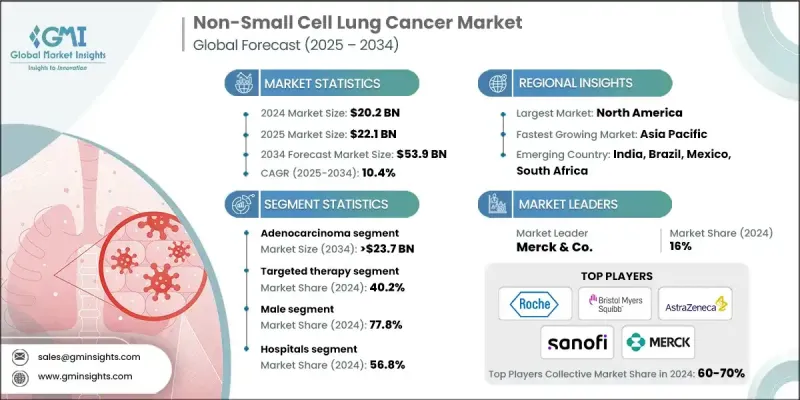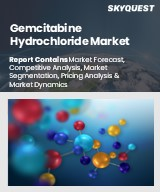
|
시장보고서
상품코드
1833441
비소세포 폐암 시장 기회, 성장 촉진요인, 산업 동향 분석 및 예측(2025-2034년)Non-Small Cell Lung Cancer Market Opportunity, Growth Drivers, Industry Trend Analysis, and Forecast 2025 - 2034 |
||||||
세계의 비소세포 폐암 시장은 2024년에는 202억 달러로 평가되었고, CAGR 10.4%로 성장하여 2034년에는 539억 달러에 이를 것으로 추정되고 있습니다.

특정 유전자 변이(EGFR, ALK, ROS1, KRAS 등)를 표적으로 하는 치료법 개발로 치료 경로가 변화하고, 맞춤 의료가 확대되었으며, 특정 환자군의 치료 결과가 크게 개선되었습니다.
| 시장 범위 | |
|---|---|
| 개시 연도 | 2024년 |
| 예측 연도 | 2025-2034년 |
| 시장 규모 | 202억 달러 |
| 예측 금액 | 539억 달러 |
| CAGR | 10.4% |
선암 유병률 증가
선암 부문은 특히 비흡연자와 젊은 환자에서 높은 유병률에 힘입어 2024년 큰 점유율을 차지할 것으로 예측됩니다. 비소세포폐암의 가장 흔한 조직학적 아형인 선암은 종종 실행 가능한 유전자 변이를 동반하기 때문에 분자 표적 치료제의 가장 중요한 타겟이 됩니다.
표적치료제 도입 증가
표적치료제 분야는 전신 독성을 최소화하면서 생존기간을 개선하는 개별화된 접근법을 제공하는 것을 배경으로 2024년 큰 점유율을 차지할 것으로 예측됩니다. 이 분야는 EGFR, ALK, BRAF, MET, KRAS 돌연변이와 같은 특정 암 유발 요인을 치료하는 여러 약물이 승인되면서 큰 탄력을 받고 있습니다. 표적치료제는 대상 환자의 1차 치료제로 선호되는 경우가 많으며, 그 결과 기존 화학요법에 비해 무진행생존기간이 길어집니다.
남성 시장이 견인차 역할을 한다
역사적으로 남성의 흡연율이 높고, 직업적으로 폐암 유발 물질에 노출되는 비율이 높기 때문에 2024년에는 남성 부문이 큰 비중을 차지할 것으로 예측됩니다. 성별에 따른 치료 프로토콜에 큰 차이는 없지만, 남성 환자의 발병률이 높기 때문에 진단, 치료 시작, 추적관찰 측면에서 불균형적인 수요가 있습니다.
북미가 추진력 있는 지역이 될 것이다
북미 비소세포폐암 시장은 탄탄한 의료 인프라, 광범위한 바이오마커 검사, 차세대 치료법의 조기 도입에 힘입어 2025년부터 2034년까지 적절한 CAGR로 성장할 것으로 예측됩니다. 이 지역은 또한 국제 임상시험에 적극적으로 참여하고 새로운 치료제를 더 빨리 시장에 출시할 수 있는 신속한 규제 경로를 통해 혜택을 누리고 있습니다. 정밀 종양학에 대한 투자 증가와 정부의 지원책으로 북미는 비소세포폐암 시장에서 우위를 유지할 것으로 예측됩니다.
비소세포폐암 산업에서 사업을 전개하고 있는 주요 기업으로는 Xcovery, Merck &&Co. Hoffmann La Roche, Bristol-Myers Squibb Company, AstraZeneca, Sun Pharmaceutical, Merus 등이 있습니다.
비소세포폐암 시장에서의 입지를 강화하기 위해 각사는 정밀종양학 포트폴리오 확대, 규제 당국의 패스트트랙을 통한 시장 출시 시간 단축 등 다양한 전략을 시행하고 있습니다. 특히 표적치료제 분야에서는 기존 치료제에 대한 내성을 극복하기 위한 차세대 억제제 개발에 주안점을 두고 있습니다. 동반진단약을 통한 환자 식별을 간소화하기 위해 진단기업과의 제휴도 핵심입니다.
목차
제1장 조사 방법과 범위
제2장 주요 요약
제3장 업계 인사이트
- 생태계 분석
- 공급업체 상황
- 각 단계에서의 부가가치
- 밸류체인에 영향을 미치는 요인
- 업계에 대한 영향요인
- 성장 촉진요인
- 비소세포 폐암 보급률 증가
- 면역치료와 표적 치료 Break through
- 진단 기술 진보
- 맞춤형 의료 도입 확대
- 업계의 잠재적 리스크&과제
- 첨단 치료 고비용
- 규제로 진단 인프라 갭
- 시장 기회
- 신흥 시장 수요 증가
- 맞춤형 치료와 병용요법에의 이동
- 성장 촉진요인
- 성장 가능성 분석
- 규제 상황
- 향후 시장 동향
- 파이프라인 분석
- 기술 및 혁신 상황
- Porter의 Five Forces 분석
- PESTEL 분석
제4장 경쟁 구도
- 서론
- 기업의 시장 점유율 분석
- 기업 매트릭스 분석
- 주요 시장 기업의 경쟁 분석
- 경쟁 포지셔닝 매트릭스
- 주요 발전
- 인수합병(M&A)
- 파트너십 및 협업
- 신제품 발매
제5장 시장 추산·예측 : 유형별, 2021-2034
- 주요 동향
- 선암
- 편평상피암
- 대세포 암
- 기타 유형
제6장 시장 추산·예측 : 치료, 2021-2034
- 주요 동향
- 화학요법
- 면역치료
- 표적치료
- 기타 치료 유형
제7장 시장 추산·예측 : 남녀별, 2021-2034
- 주요 동향
- 남성
- 여성
제8장 시장 추산·예측 : 최종 용도별, 2021-2034
- 주요 동향
- 병원
- 전문 클리닉
- 기타 용도
제9장 시장 추산·예측 : 지역별, 2021-2034
- 주요 동향
- 북미
- 미국
- 캐나다
- 유럽
- 독일
- 영국
- 프랑스
- 스페인
- 이탈리아
- 네덜란드
- 아시아태평양
- 중국
- 일본
- 인도
- 호주
- 한국
- 라틴아메리카
- 브라질
- 멕시코
- 아르헨티나
- 중동 및 아프리카
- 남아프리카공화국
- 사우디아라비아
- 아랍에미리트
제10장 기업 개요
- AbbVie
- Astellas Pharma
- AstraZeneca
- Bristol-Myers Squibb Company
- Eli Lilly
- F. Hoffmann La Roche
- Janssen Biotech
- Merck &Co.
- Merus
- Novartis
- Pfizer
- Sanofi
- Sun Pharmaceutical
- Takeda
- Xcovery
The Global Non-Small Cell Lung Cancer Market was valued at USD 20.2 billion in 2024 and is estimated to grow at a CAGR of 10.4% to reach USD 53.9 billion by 2034.

The development of therapies targeting specific genetic mutations (like EGFR, ALK, ROS1, and KRAS) has transformed treatment pathways, expanded personalized medicine and significantly improved outcomes in select patient groups.
| Market Scope | |
|---|---|
| Start Year | 2024 |
| Forecast Year | 2025-2034 |
| Start Value | $20.2 Billion |
| Forecast Value | $53.9 Billion |
| CAGR | 10.4% |
Rising Prevalence of Adenocarcinoma
The adenocarcinoma segment held a significant share in 2024, driven by its high prevalence, particularly among non-smokers and younger patients. As the most common histological subtype of NSCLC, adenocarcinoma is often associated with actionable genetic mutations, making it a prime focus for molecularly targeted therapies.
Increasing Adoption of Targeted Therapy
The targeted therapy segment held a sizeable share in 2024, backed by offering a personalized approach that improves survival while minimizing systemic toxicity. This segment has gained strong momentum due to the approval of multiple agents addressing specific oncogenic drivers like EGFR, ALK, BRAF, MET, and KRAS mutations. Targeted drugs are often preferred as first-line treatments for eligible patients, resulting in longer progression-free survival compared to traditional chemotherapy.
Male Sector to Gain Traction
The male segment generated a substantial share in 2024, owing to historically higher rates of smoking and occupational exposure to lung carcinogens among men. Although gender-based treatment protocols do not significantly differ, the higher incidence among male patients drives disproportionate demand in terms of diagnostics, therapy initiation, and follow-up care.
North America to Emerge as a Propelling Region
North America non-small cell lung cancer market will grow at a decent CAGR during 2025-2034, fueled by robust healthcare infrastructure, widespread biomarker testing, and early adoption of next-generation therapies. The region also benefits from active participation in global clinical trials and fast-track regulatory pathways that bring novel treatments to market faster. With rising investment in precision oncology and supportive government initiatives, North America is expected to maintain its dominant position in the NSCLC landscape.
Some prominent players operating in the non-small cell lung cancer industry include Xcovery, Merck & Co., Janssen Biotech, Sanofi, AbbVie, Novartis, Astellas Pharma, Pfizer, Eli Lilly, Takeda, F. Hoffmann La Roche, Bristol-Myers Squibb Company, AstraZeneca, Sun Pharmaceutical, and Merus.
To strengthen their presence in the non-small cell lung cancer market, companies are implementing a range of strategies, including expanding their precision oncology portfolios and accelerating time-to-market through regulatory fast-tracks. A major focus lies in developing next-generation inhibitors to overcome resistance to existing therapies, particularly in the targeted therapy segment. Collaborations with diagnostic firms are also key, as they enable streamlined patient identification through companion diagnostics.
Table of Contents
Chapter 1 Methodology and Scope
- 1.1 Market scope and definitions
- 1.2 Research design
- 1.2.1 Research approach
- 1.2.2 Data collection methods
- 1.3 Data mining sources
- 1.3.1 Global
- 1.3.2 Regional/country
- 1.4 Base estimates and calculations
- 1.4.1 Base year calculation
- 1.4.2 Key trends for market estimation
- 1.5 Primary research and validation
- 1.5.1 Primary sources
- 1.6 Forecast model
- 1.7 Research assumption and limitations
Chapter 2 Executive Summary
- 2.1 Industry 3600 synopsis
- 2.2 Key market trends
- 2.2.1 Regional
- 2.2.2 Type
- 2.2.3 Treatment
- 2.2.4 Gender
- 2.2.5 End use
- 2.3 CXO perspectives: Strategic imperatives
- 2.3.1 Key decision points for industry executives
- 2.3.2 Critical success factors for market players
- 2.4 Future outlook and strategic recommendations
Chapter 3 Industry Insights
- 3.1 Industry ecosystem analysis
- 3.1.1 Supplier landscape
- 3.1.2 Value addition at each stage
- 3.1.3 Factor affecting the value chain
- 3.2 Industry impact forces
- 3.2.1 Growth drivers
- 3.2.1.1 Increasing prevalence of non-small cell lung cancer
- 3.2.1.2 Breakthroughs in immunotherapy and targeted treatments
- 3.2.1.3 Advancements in diagnostic technologies
- 3.2.1.4 Growing adoption of personalized medicine
- 3.2.2 Industry pitfalls and challenges
- 3.2.2.1 High cost of advanced therapies
- 3.2.2.2 Regulatory and diagnostic infrastructure gaps
- 3.2.3 Market opportunities
- 3.2.3.1 Rising demand in emerging markets
- 3.2.3.2 Shift toward personalized and combination therapies
- 3.2.1 Growth drivers
- 3.3 Growth potential analysis
- 3.4 Regulatory landscape
- 3.4.1 North America
- 3.4.2 Europe
- 3.4.3 Asia Pacific
- 3.4.4 Latin America
- 3.4.5 Middle East and Africa
- 3.5 Future market trends
- 3.6 Pipeline analysis
- 3.7 Technology and innovation landscape
- 3.8 Porter's analysis
- 3.9 PESTEL analysis
Chapter 4 Competitive Landscape, 2024
- 4.1 Introduction
- 4.2 Company market share analysis
- 4.3 Company matrix analysis
- 4.4 Competitive analysis of major market players
- 4.5 Competitive positioning matrix
- 4.6 Key developments
- 4.6.1 Merger and acquisition
- 4.6.2 Partnership and collaboration
- 4.6.3 New product launches
Chapter 5 Market Estimates and Forecast, By Type, 2021 - 2034 ($ Mn)
- 5.1 Key trends
- 5.2 Adenocarcinoma
- 5.3 Squamous cell carcinoma
- 5.4 Large cell carcinoma
- 5.5 Other types
Chapter 6 Market Estimates and Forecast, By Treatment, 2021 - 2034 ($ Mn)
- 6.1 Key trends
- 6.2 Chemotherapy
- 6.3 Immunotherapy
- 6.4 Targeted therapy
- 6.5 Other treatment types
Chapter 7 Market Estimates and Forecast, By Gender, 2021 - 2034 ($ Mn)
- 7.1 Key trends
- 7.2 Male
- 7.3 Female
Chapter 8 Market Estimates and Forecast, By End Use, 2021 - 2034 ($ Mn)
- 8.1 Key trends
- 8.2 Hospitals
- 8.3 Specialty clinics
- 8.4 Other end use
Chapter 9 Market Estimates and Forecast, By Region, 2021 - 2034 ($ Mn)
- 9.1 Key trends
- 9.2 North America
- 9.2.1 U.S.
- 9.2.2 Canada
- 9.3 Europe
- 9.3.1 Germany
- 9.3.2 UK
- 9.3.3 France
- 9.3.4 Spain
- 9.3.5 Italy
- 9.3.6 Netherlands
- 9.4 Asia Pacific
- 9.4.1 China
- 9.4.2 Japan
- 9.4.3 India
- 9.4.4 Australia
- 9.4.5 South Korea
- 9.5 Latin America
- 9.5.1 Brazil
- 9.5.2 Mexico
- 9.5.3 Argentina
- 9.6 Middle East and Africa
- 9.6.1 South Africa
- 9.6.2 Saudi Arabia
- 9.6.3 UAE
Chapter 10 Company Profiles
- 10.1 AbbVie
- 10.2 Astellas Pharma
- 10.3 AstraZeneca
- 10.4 Bristol-Myers Squibb Company
- 10.5 Eli Lilly
- 10.6 F. Hoffmann La Roche
- 10.7 Janssen Biotech
- 10.8 Merck & Co.
- 10.9 Merus
- 10.10 Novartis
- 10.11 Pfizer
- 10.12 Sanofi
- 10.13 Sun Pharmaceutical
- 10.14 Takeda
- 10.15 Xcovery



















